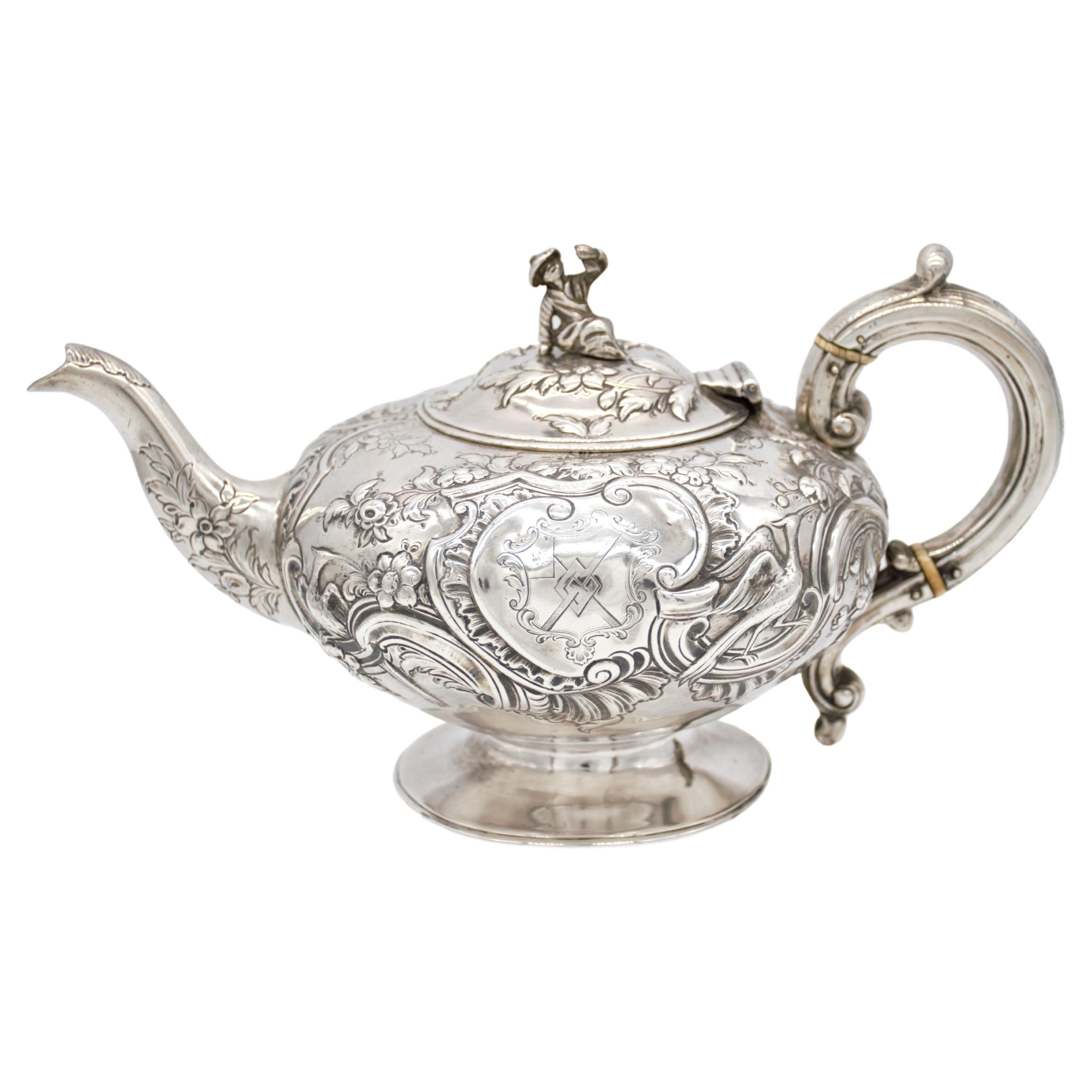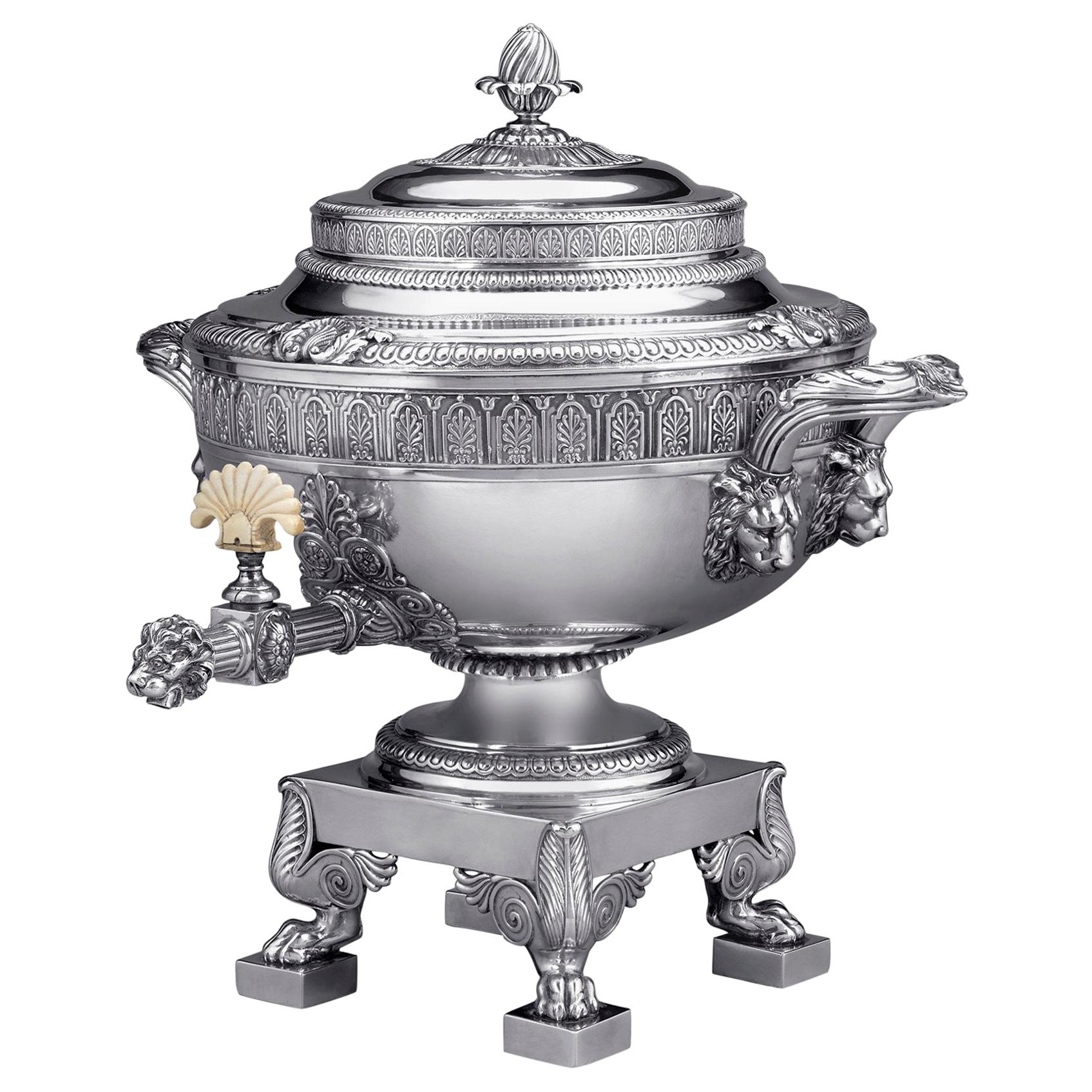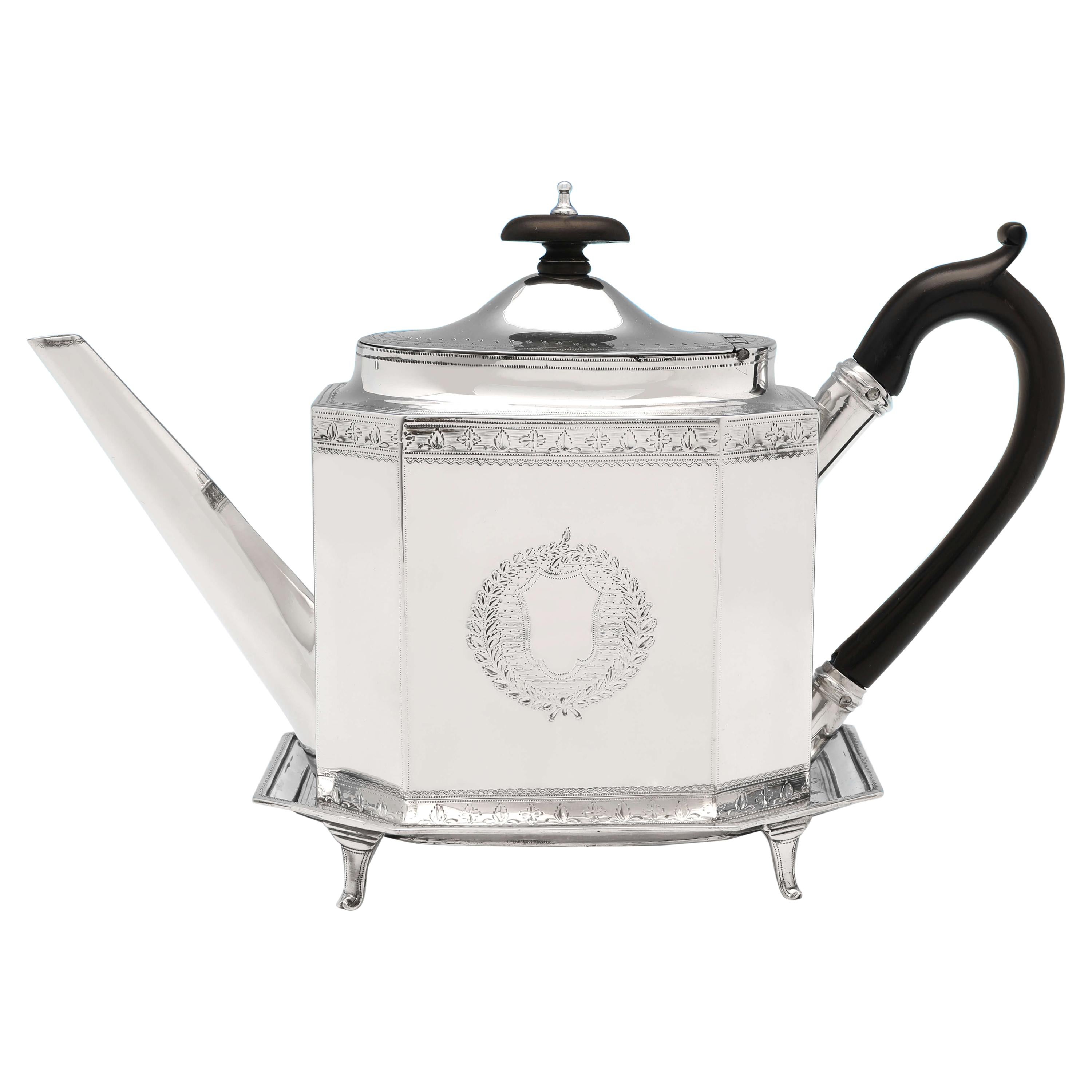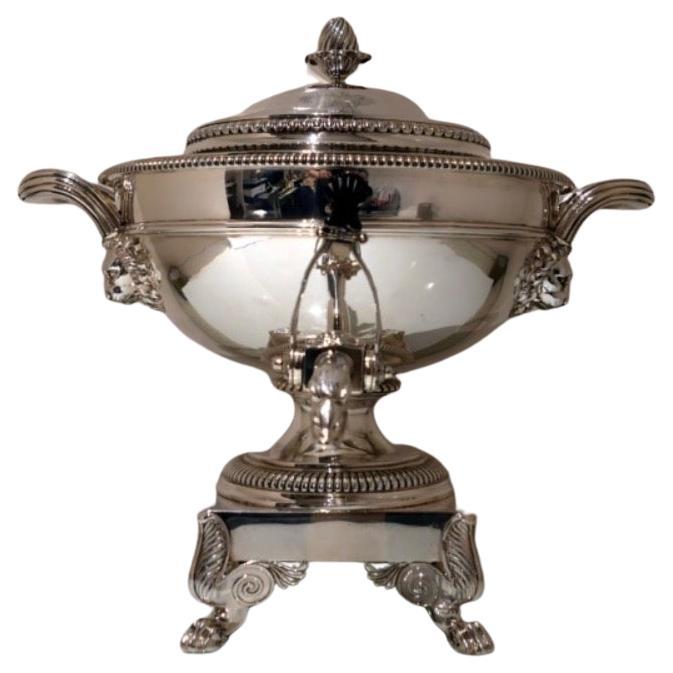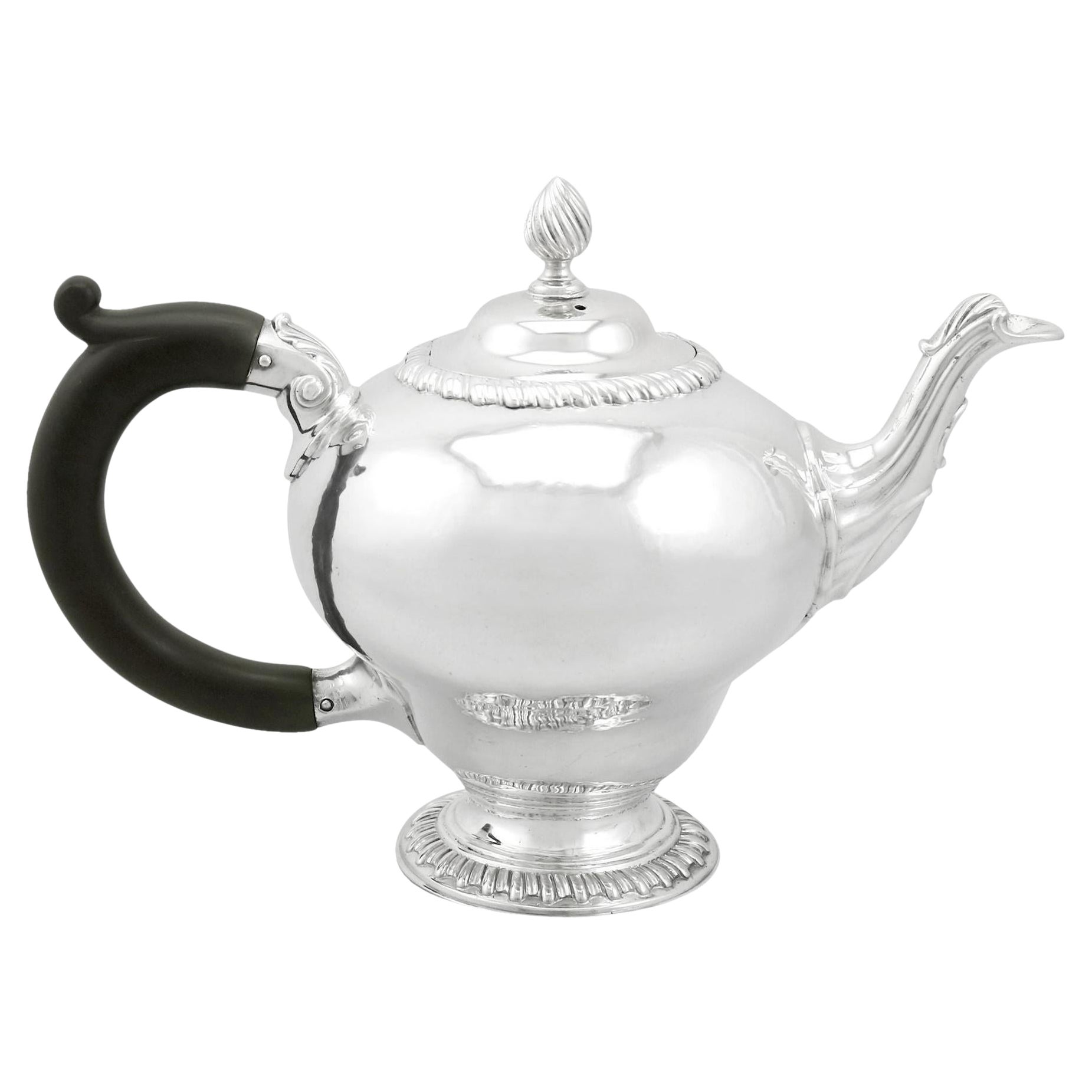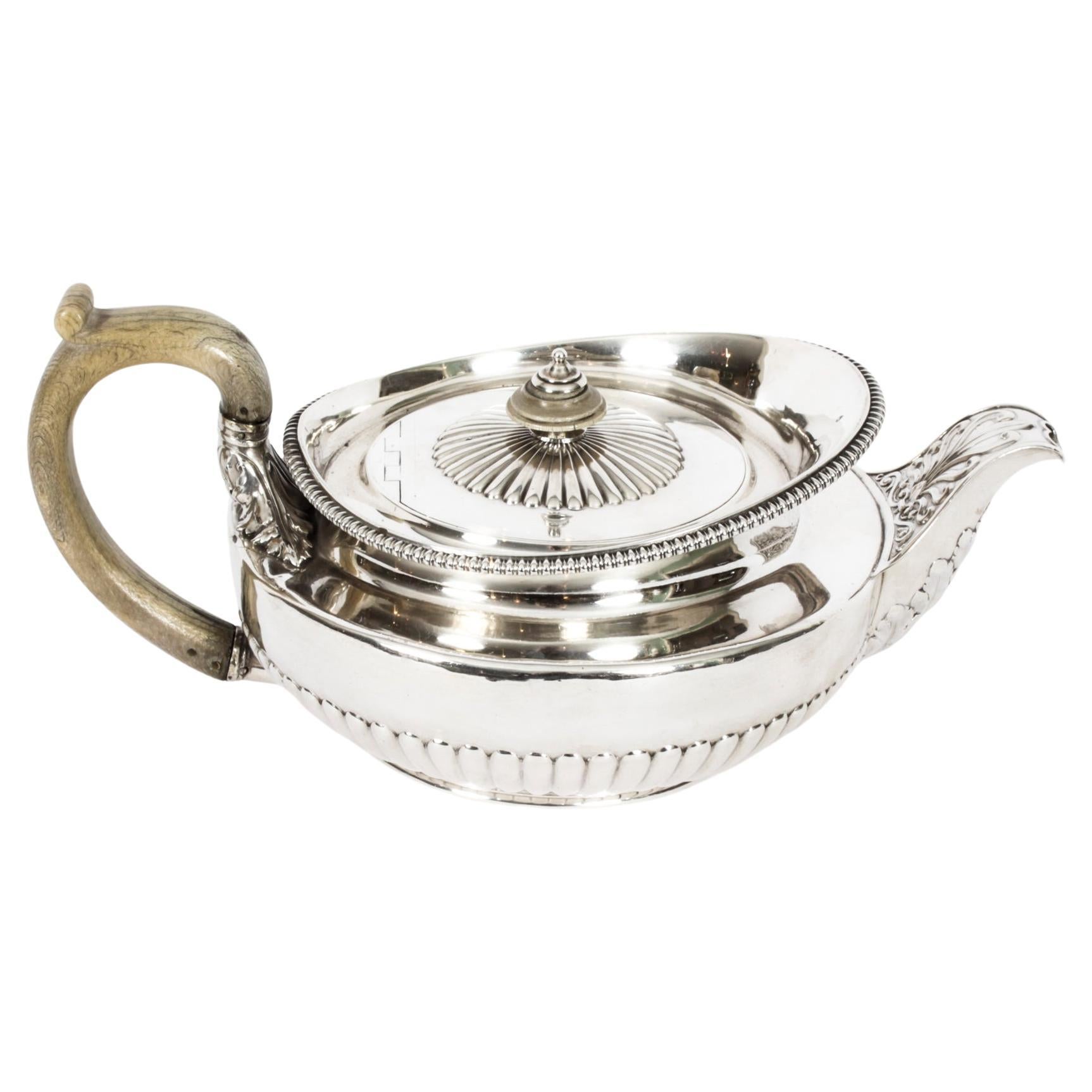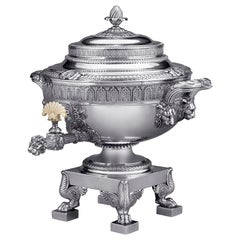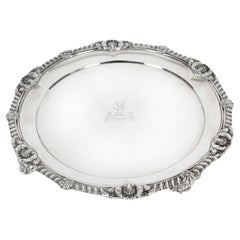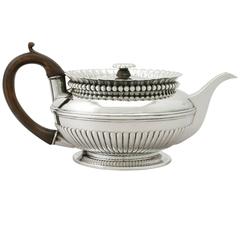
Sterling Silver Teapot by Paul Storr, Antique George III
View Similar Items
Want more images or videos?
Request additional images or videos from the seller
1 of 11
Sterling Silver Teapot by Paul Storr, Antique George III
About the Item
- Creator:Paul Storr (Maker)
- Dimensions:Height: 4.9 in (12.45 cm)Diameter: 6.3 in (16.01 cm)
- Style:Georgian (Of the Period)
- Materials and Techniques:
- Place of Origin:
- Period:
- Date of Manufacture:1817
- Condition:This antique Paul Storr teapot is an exceptional gauge of silver, exceptional quality and in exceptional condition. The decoration is all very sharp. Full and part hallmarks are all very clear.
- Seller Location:Jesmond, GB
- Reference Number:Seller: A39921stDibs: LU120023257922
About the Seller
5.0
Recognized Seller
These prestigious sellers are industry leaders and represent the highest echelon for item quality and design.
Platinum Seller
These expertly vetted sellers are 1stDibs' most experienced sellers and are rated highest by our customers.
Established in 1977
1stDibs seller since 2015
658 sales on 1stDibs
Typical response time: 13 hours
Associations
LAPADA - The Association of Arts & Antiques DealersInternational Confederation of Art and Antique Dealers' Associations
More From This SellerView All
- George I Style Vintage Sterling Silver Bachelor TeapotBy Thomas Ducrow & SonsLocated in Jesmond, Newcastle Upon TyneA fine and impressive vintage Elizabeth II English sterling silver bachelor teapot, in the George I style; an addition to our silver teaware collection. This fine vintage Elizabeth II sterling silver bachelor teapot has a bullet shaped form onto a circular collet foot, in the George I style. The surface of this vintage silver teapot is plain and unembellished. This sterling teapot is fitted with a hinged subtly domed cover and retains the original carved pear wood and hallmarked sterling silver finial; the finial secures to the interior of the cover with a wingnut. This fine teapot is fitted with the original plain S scroll carved pear wood handle featuring a scrolling thumbpiece and plain cylindrical sockets. This bullet teapot...Category
Vintage 1950s English George I Sterling Silver
MaterialsSilver, Sterling Silver
- Antique Georgian Sterling Silver Bachelor TeapotLocated in Jesmond, Newcastle Upon TyneAn exceptional, fine and impressive antique George III English sterling silver bachelor teapot; an addition to our Georgian silver teaware collection This exceptional antique Edwardian sterling silver teapot has an inverted pear shaped form onto a circular spreading foot. The surface of the bachelor teapot is plain and unembellished. The upper rim of the body is ornamented with a band of cast and applied gadroon decoration all in a swirl design. This antique silver teapot is fitted with a hallmarked, domed flush hinged cover surmounted with an impressive and original, cast sterling silver flame style finial; the flush hinge indicates the high quality of the piece. This exceptional example of antique teaware retains the original C scroll carved painted wood handle featuring a plain scrolling thumbpiece and a cast silver leaf decorated design to the upper socket, This impressive example of antique silverware has a cast silver swan necked spout embellished with fluted decoration and applied leaf motif to the lip. The ornamentation to the underside of the spout incorporates a vacant oval cartouche below a shell motif. The cast circular spreading foot is encircled with further gadroon decoration to the rim. Note: This maker may have been recorded in the missing 1739-1758 Smallworkers' Register or the 1758-1773 Largeworkers' Register, determining this maker's mark to be classed as 'unidentified' in all documents. The mark has been discovered on other holloware items such as mugs, salts and sauce boats. Condition This antique silver teapot for one...Category
Antique 18th Century English George III Sterling Silver
MaterialsSilver, Sterling Silver
- Antique Victorian Sterling Silver TeapotBy Charles Reily & George StorerLocated in Jesmond, Newcastle Upon TyneAn exceptional, fine and impressive antique Victorian English sterling silver teapot; an addition to our silver teaware collection This exce...Category
Antique 19th Century English Victorian Tea Sets
MaterialsSilver, Sterling Silver
- Paul Storr Antique Georgian Sterling Silver SaltsBy Paul StorrLocated in Jesmond, Newcastle Upon TyneAn exceptional, fine and impressive set of three antique Georgian English sterling silver salts made by Paul Storr; an addition to our silver cruet and condiment collection. These...Category
Antique 1810s British George III Sterling Silver
MaterialsSilver, Sterling Silver
- Antique Sterling Silver Gilt Beaker by Paul StorrBy Paul StorrLocated in Jesmond, Newcastle Upon TyneAn exceptional, fine and impressive antique English sterling silver gilt beaker made by Paul Storr; an addition to our continental silverware collection. ...Category
Antique 1830s British Sterling Silver
MaterialsSterling Silver
- Elkington & Co. Vintage Sterling Silver TeapotBy Elkington & Co.Located in Jesmond, Newcastle Upon TyneAn exceptional, fine and impressive vintage Elizabeth II English sterling silver teapot made in the George I style; an addition to the silver teaware collection. This exceptional Elizabeth II English sterling silver teapot has a plain oval rounded form onto an oval domed spreading foot, in the Classic George I style. The surface of this vintage silver teapot...Category
Vintage 1960s English George I Sterling Silver
MaterialsSterling Silver
You May Also Like
- exceptional George III teapot by preeminent silversmith Paul Storr, 1793By Paul StorrLocated in Tel Aviv - Jaffa, ILThis rare and exceptional George III teapot is the work of preeminent Georgian silversmith Paul Storr, it is one of his earliest works, the date mark on this pieces of the year 1793 which is the first year Storr marked items with his own initials (P S) The teapot is designed in the neoclassical taste with some Chinese influences, or Chinoiserie taste, even the figure on the cover of the teapot is Chinese. It is very hard to impossible to find works from this early period with this interesting Royalty provenance. The family crest on the front is of the Tollemache family, and dating of The teapot indicate It belonged and probably commissioned by or as a gift to William Manners Tollemache, Lord Huntingtower, William, On 12 January 1793, at the Age of 26, he Was created a Baronet, of Hanby Hall in the County of Lincoln. So this teapot was commissioned to celebrate the occasion. William Manners Tollemache: Lord Huntingtower (19 May 1766 – 11 March 1833), known as Sir William Manners, Bt, between 1793 and 1821, was a British nobleman And Tory politician. Born William Manners, he was the eldest son of John Manners and Louisa Tollemache, 7th Countess of Dysart. On 12 January 1793, at the age of 26, he was Ceated a Baronet, of Hanby Hall in the County of Lincoln.On his mother's Succession to the earldom in 1821, he was styled Lord Huntingtower, and adopted The surname of Talmash or Tollemache Paul Storr: (baptised 28 October 1770 in London – 18 March 1844 in London) was an English goldsmith and silversmith working in the Neoclassical and other styles During the late eighteenth and early nineteenth centuries. His works range from Simple tableware to magnificent sculptural pieces made for royalty Paul Storr was England's most celebrated silversmith during the first half of the Nineteenth century and his legacy lives on today. His pieces historically and Currently adorn royal palaces and the finest stately homes throughout Europe and The world. Storr's reputation rests on his mastery of the grandiose neo-Classical Style developed in the Regency period. He quickly became the most prominent Silversmith of the nineteenth century, producing much of the silver purchased by King George III and King George IV. Storr entered his first mark in the first part of 1792, which reflects his short-lived partnership with William Frisbee. Soon after, he Began to use his PS mark, which he maintained throughout his career with only Minor changes. His first major work was a gold font commissioned by the Duke of Portland...Category
Antique 1790s English Neoclassical Tea Sets
MaterialsSilver
- 19th Century Paul Storr Silver Tea UrnBy Rundell, Bridge & Rundell, Paul StorrLocated in New Orleans, LAThis extraordinarily rare and masterfully crafted tea urn is by the hand of the master Georgian silversmith Paul Storr. Created by Storr while working for Rundell, Bridge and Rundell, Jewelers and Goldsmiths to the King, this magnificent piece truly represents the sophisticated style of the renowned firm and the enormous talents of Paul Storr. Applied and engraved decoration envelop this masterpiece equipped with a carved handle, lion's head spigot and spectacular lion's paw supports. The piece bears the arms of the Neave Baronetcy with those of Digby, for Sir Thomas Neave and his wife Frances Caroline, daughter of the Hon. William Digby, the Dean of Durham. Though he held no formal title, Storr enjoyed patronage from the most important and powerful figures of the period including King George III and the Prince of Wales, the future King George IV. His first major work was a gold font commissioned by the Duke of Portland in 1797, and in 1799 he created the “Battle of the Nile...Category
Antique 19th Century English Georgian Sterling Silver
MaterialsSilver
- Antique George III Sterling Silver Salver by Paul Storr 1811 19th CenturyBy Paul StorrLocated in London, GBThis is a wonderful English antique George III sterling silver 10 inch salver, by the world famous silversmith Paul Storr. It has clear hallmarks for London 1811 and the makers mark of Paul Storr. It is typical of his work with the raised gadrooned rim with anthemion at intervals, on four fabulous foliate bracket feet. The salver is engraved with a crest and motto and the underside is later engraved Charlotte J. Parke from C. J. Parke, March 1893' The centre is engraved with a crest above a motto 'True and Fast' and I have researched this crest: The Crest of Parke The crest as engraved upon this George III English Sterling Silver Footed Salver by Paul Storr hallmarked London 1811 is that of the family of Parke. It may be blazoned as follows: Crest: A stag’s head couped sable holding in the mouth a key or Motto: True and fast The family of Parke originally hailed from the County of Cumberland in the northeast of England1 later settling in the County of Dorset at Henbury House, Sturminster Marshal, near Wimborne. Given the evidence of the inscription found on the underside of the salver ‘Charlotte J. Parke from C. J. Parke, March 1893’ it was undoubtedly at one time in the possession of Charles Joseph Parke (died 9th March 1893) of Henbury House aforesaid and gifted to Charlotte Josephine Parke (baptised 4th January 1857 died 2nd January 1941) his third daughter by his wife, Ellen Mary Ethelston. I would venture the following hypothesis that the salver was bequeathed to Charlotte in her father’s will that was granted probate at London on the 20th May 1893. The ‘March 1893’ of the inscription acts as a remembrance of the month of the death of her father. It was noted that Charlotte’s father left an estate worth some £66,892, 19 shillings and one pence, a very considerable sum in the last decade of the 19th Century and even thereafter. Charlotte never married and was living at the time of her death at The Coppice, Sixpenny Handley in the County of Dorset. Her will was proved for probate at Llandudno on the 25th March 1941. She left an estate worth £18,866, 10 shillings and 4 pence. Again, a comfortable sum in 1941. See the photo of Henbury House, Sturminster Marshal, near Wimborne, Co. Dorset. The former seat of the Parke family. The house was destroyed by fire, the remains of which were demolished in the 1990's. There is no mistaking its unique quality and design, which is sure to make it a treasured piece by any discerning collector. Condition: In excellent condition with clear hallmarks and no dings, dents or signs of repair. Please see photos for confirmation. Dimensions in cm: Height 2 x Width 26.5 x Depth 26.5 Weight 0.69 kg Dimensions in inches: Height 1 inch x Width 10 inches x Depth 10 inches Weight 1.5 lbs Paul Storr born in London England in 1771, was to become one of the most talented silversmiths of the nineteenth century. Today his legacy of exceptionally well crafted silver, found worldwide in museums and private collections, leaves one in awe when compared to that of his contemporaries.After having served a seven year apprenticeship from the age of 14, he began his career in 1792 when he went into a brief partnership with William Frisbee. This did not last and in 1793 a new mark, (his initials ‘P S’) was entered. By the beginning of the nineteenth century he had established himself as one of London’s top silversmiths producing, amongst others, commissions for Royalty. In 1801 he married Elizabeth Susanna Beyer with whom he was to have ten children. In 1807 Paul Storr entered into a working relationship with Philip Rundell and by 1811 was a partner, and managing the workshops for Rundell, Bridge & Rundell. During this period he kept his own marks and separate workshop. However it was through Rundell, Bridge & Rundell who were appointed Goldsmith in Ordinary to George III in 1804 that his reputation as a master silversmith grew. His talents lay in being able to transform ideas and designs from Rundell, Bridge & Rundell’s designers, William Theed...Category
Antique 1810s English George III Sterling Silver
MaterialsSterling Silver
- George III Neoclassical Antique Sterling Silver Teapot & Stand from 1793-1794By George Smith and Thomas HayterLocated in London, LondonHallmarked in London in 1793 & 1794 by George Smith II & Thomas Hayter, this very handsome, George III, antique sterling silver teapot on stand,...Category
Antique 1790s English Neoclassical Sterling Silver
MaterialsSterling Silver
- 19th Century Antique George III Sterling Silver Tea Urn London 1813 Paul StorrBy Paul StorrLocated in London, GBA truly stunning silver hemispherical tea urn decorated with gadroon borders for highlights. The body has a stylish upper girdled wire and a ‘serpent’ themed tap. The lion mane ha...Category
Antique 1810s British Regency Tea Sets
MaterialsSilver
- Antique Rare Georgian Sterling Silver Teapot by Paul Storr 1817, 19th CenturyBy Paul StorrLocated in London, GBThis is an exceptional and very rare antique English George III sterling silver teapot by the world-famous silversmith, Paul Storr, and bearing hallmarks for 1817. This splendid teapot is of a delightful shape and it is profusely chased with half ribbed fluting decoration. It is further embellished with wonderful foliate motifs below and above the spout and stunning gadrooned shaped borders to the top of the teapot and the base. The remarkable quality flush hinged lid is also beautifully surmounted by a delightful round finial. It features an exceptional horn handle with striking details, proving the silversmith's exceptional mastery in the creation of unique and luxurious silverware - Paul Storr never tired of adding detail to create a true piece of artwork. The underside of the teapot bear full hallmarks: the Lion passant for sterling silver, the leopard head for London, the letter for 1817 and the maker's marks 'PS' for Paul Storr. There is no mistaking its unique quality and design, which is sure to make it a treasured piece by any discerning collector. Condition: In excellent condition with clear hallmarks and no dings, dents or signs of repair. Please see photos for confirmation. Dimensions in cm: height 12.5 x width 18 x depth 18 Weight 0.88 kg Dimensions in inches: height 5 inches x width 7 inches x depth 7 inches Weight 28.2 troy oz Paul Storr born in London England in 1771, was to become one of the most talented silversmiths of the nineteenth century. Today his legacy of exceptionally well crafted silver, found worldwide in museums and private collections, leaves one in awe when compared to that of his contemporaries.After having served a seven year apprenticeship from the age of 14, he began his career in 1792 when he went into a brief partnership with William Frisbee. This did not last and in 1793 a new mark, (his initials ‘P S’) was entered. By the beginning of the nineteenth century he had established himself as one of London’s top silversmiths producing, amongst others, commissions for Royalty. In 1801 he married Elizabeth Susanna Beyer with whom he was to have ten children. In 1807 Paul Storr entered into a working relationship with Philip Rundell and by 1811 was a partner, and managing the workshops for Rundell, Bridge & Rundell. During this period he kept his own marks and separate workshop. However it was through Rundell, Bridge & Rundell who were appointed Goldsmith in Ordinary to George III in 1804 that his reputation as a master silversmith grew. His talents lay in being able to transform ideas and designs from Rundell, Bridge & Rundell’s designers, William Theed...Category
Antique 1810s English George III Sterling Silver
MaterialsSterling Silver
Recently Viewed
View AllMore Ways To Browse
Paul Storr Teapot
Ice Shovel
Gorham Silver Serving Dish
John Reed
Ep France
Lion Foot Furniture
Compact Mirror Guilloche
1949 Silver
Sterling Silver Gravy Bowl
Svend Toxvaerd
Tiffany Pumpkin
Colflesh Gorham
Donald Colflesh
Etruscan Silverware
Georg Jensen Lobster
Jensen Continental Server
Lily Of The Valley Cake
Shreve Co Sterling Soup Ladle
